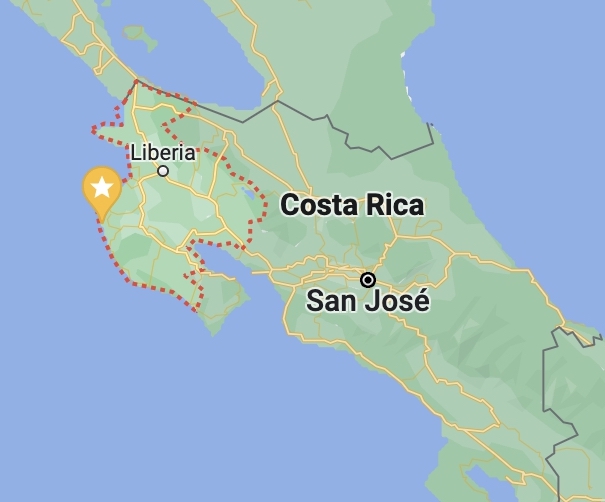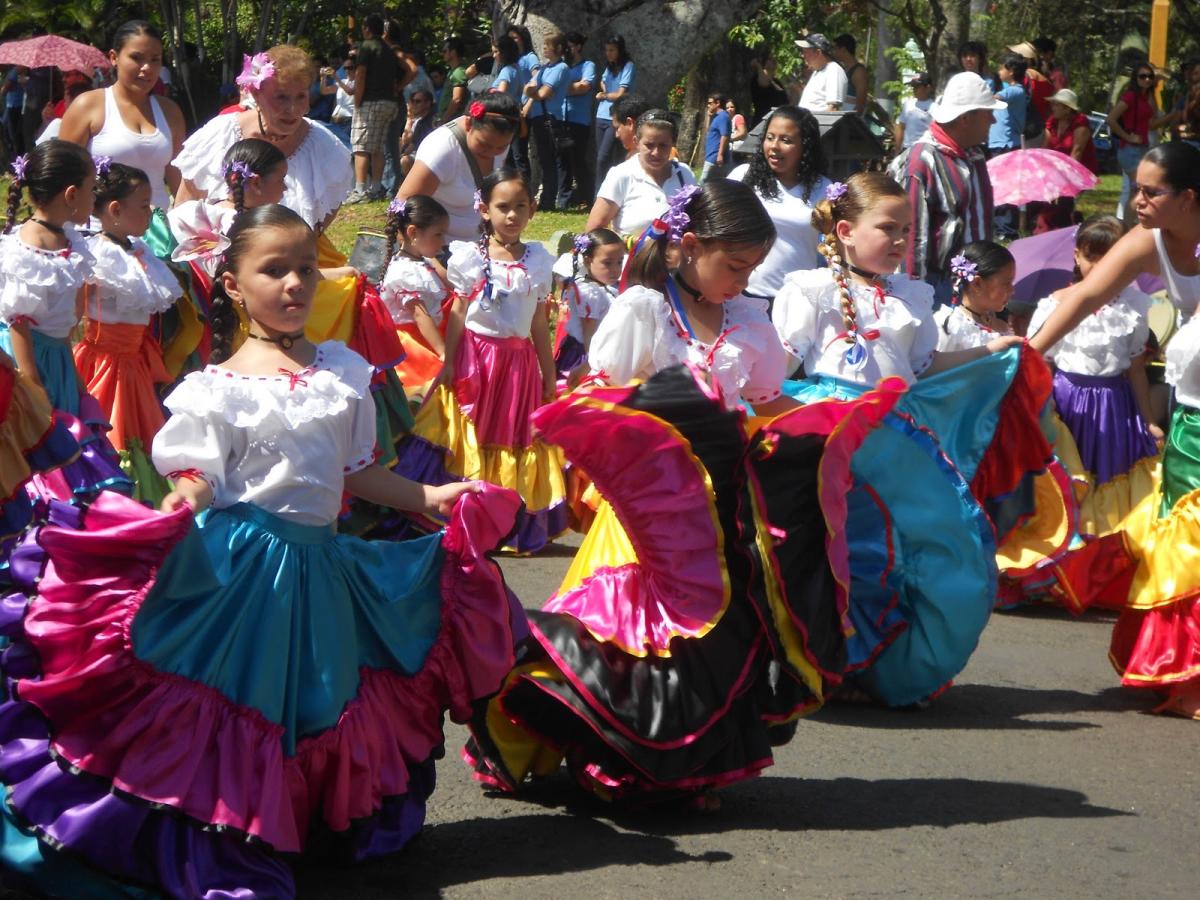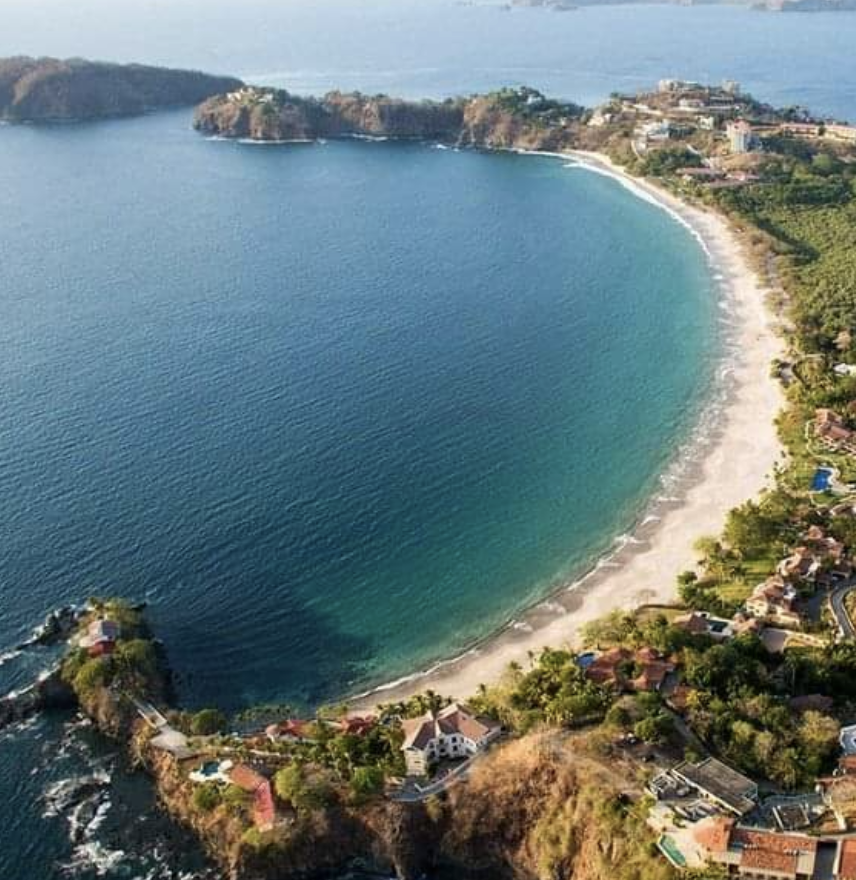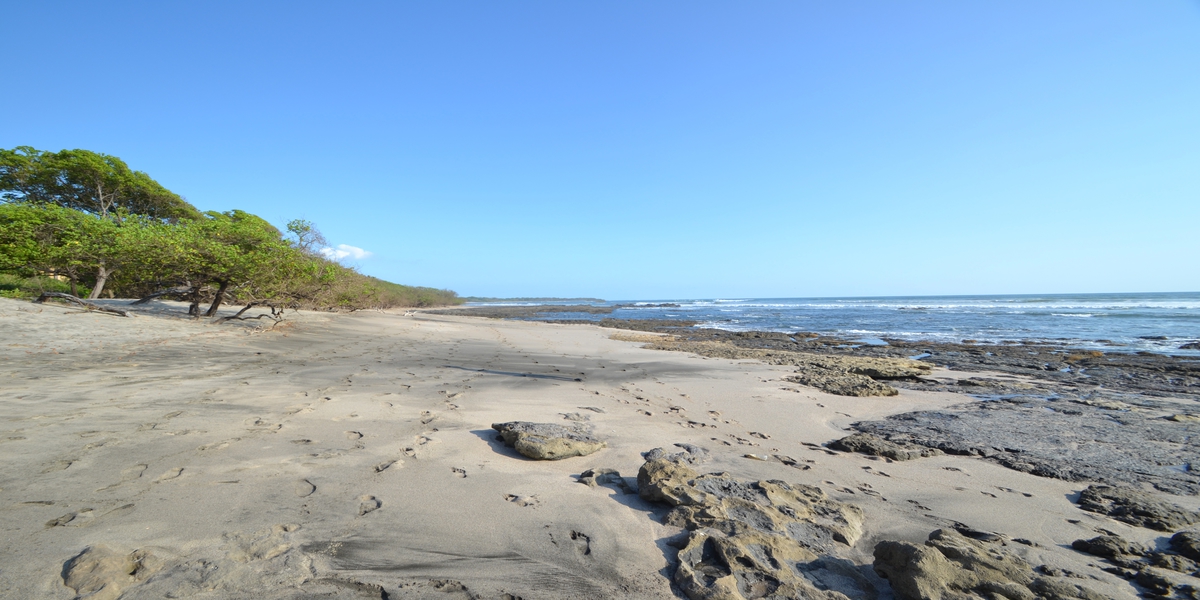Guanacaste province, the most popular tourist destination in Costa Rica, has it all. If offers its visitors and residents world-class lodging and dining as well as every land and sea activity imaginable. The consistent tropical climate and well-developed infrastructure allow you to enjoy its amenities year-round. Here’s a complete guide to Guanacaste Costa Rica.
Geography of Guanacaste
 Guanacaste fills the northwestern corner of Costa Rica’s map. It is bordered on the west by more than 65 beaches along 400 miles of coastline on the Pacific Ocean. Its eastern border, the mountain range Cordillera de Guanacaste, features numerous volcanoes—Orosi, Rincón de la Vieja, Miravalles, and Tenorio—and forms part of the continental divide. Miravalles volcano is its highest point at 6,627 feet (2,020 meters). The rivers that form in these mountains flow to the flatlands and blend into the Tempisque River which empties into the Gulf of Nicoya. The area sandwiched between the Gulf of Nicoya to the east and the Pacific Ocean to the west is known as the Nicoya Peninsula. Guanacaste’s terrain varies from misty forests in the mountains to dry plains and tropical dry forests nearer the coast with some wetlands in between. A constant feature of the region is the majestic guanacaste tree, a source of food for wildlife, wood for fine furniture, shade for livestock, and the name of the province.
Guanacaste fills the northwestern corner of Costa Rica’s map. It is bordered on the west by more than 65 beaches along 400 miles of coastline on the Pacific Ocean. Its eastern border, the mountain range Cordillera de Guanacaste, features numerous volcanoes—Orosi, Rincón de la Vieja, Miravalles, and Tenorio—and forms part of the continental divide. Miravalles volcano is its highest point at 6,627 feet (2,020 meters). The rivers that form in these mountains flow to the flatlands and blend into the Tempisque River which empties into the Gulf of Nicoya. The area sandwiched between the Gulf of Nicoya to the east and the Pacific Ocean to the west is known as the Nicoya Peninsula. Guanacaste’s terrain varies from misty forests in the mountains to dry plains and tropical dry forests nearer the coast with some wetlands in between. A constant feature of the region is the majestic guanacaste tree, a source of food for wildlife, wood for fine furniture, shade for livestock, and the name of the province.
The History of Guanacaste
Guanacaste’s origins began centuries ago with the Chorotega ethnic group. Their settlements included Diriá, Pocosí, and Papagayo, names that are still seen around Guanacaste today. While the Chorotega inhabited the coastal and peninsula areas, the Corobici and Nahuas lived farther inland on the eastern shore of the Gulf of Nicoya and beyond. According to World Heritage, the first Europeans settled in Guanacaste when Franciscan missionaries established the Nicoya parish between 1522 and 1544. Nicoya was the early capital of the region, and a church that still stands today was built there in 1644. The well-known Church of San Blas has survived numerous earthquakes. In the 18th century, settlers from Rivas, Nicaragua traveled south to build homes and develop cattle farms in the northern part of the Nicoya Peninsula. When they became tired of the violence and conflict caused by a series of civil wars in their home country of Nicaragua, they requested to be annexed to Costa Rica. Nicoya and the entire Guanacaste region became part of Costa Rica on July 25, 1824. The city of Liberia, originally known as Guanacaste, has been its capital since 1836.
Guanacaste's Climate
Guanacaste has two distinct seasons—one wet and one dry. Rains usually begin in May and are a daily occurrence through November. During the “green” season, mornings are usually partly cloudy then become mostly cloudy until it rains in the afternoon. The rainiest months are September and October. But don’t worry—Guanacaste enjoys 320 sunny days annually. In the dry season, you can expect mostly sunny skies from dawn to dusk. The temperature is relatively constant throughout the year with lows in the 70s and highs in the 90s. The only exception in the Guanacaste province is in the foothills of the volcanoes where temperatures are cooler and the rain is more frequent due to the higher elevation. 
Guanacaste's Economy
Historically, the primary source of income in Guanacaste was cattle ranching, and ranching continues to be important. Pastures filled with grazing Brahman cattle can still be seen throughout the province. Vaqueros (cowboys) on horseback move them along back roads from one field to another. Sugar cane and rice are the most valuable field crops in Guanacaste, but mangos, pineapples, and melons are also cultivated. Since the late 1990s, the growth of tourism in Guanacaste has outpaced the agricultural sectors. According to Tico Times, tourism now accounts for 70% of the region’s economy. The tourism industry overcame setbacks caused by the economic downturn in 2008-2009 and the recent Covid-19 pandemic and is now the most important source of income. Costa Rica welcomes more than 3 million international tourists annually—far more than any other Central American country—and many of them visit Guanacaste. Thousands of Ticos work in tourism and related industries including hotels, restaurants, transportation, and construction.
The Culture of the Guanacastecos
 Guanacastecos are proud of their heritage and maintain many traditions of their ancestors. Horse parades (“topes”) and bull festivals reflect their cattle ranching heritage. The bull festivals are different than the bullfighting or bull riding celebrated in other cultures. Guanacastecos show their bravery by running with a bull in a closed arena. Folk dances show off the colorful dresses of the women and the traditional white shirts, dark trousers, and handkerchiefs of the men. The Andalusian-influenced dances include “El Punto Guanacasteco”, “La Flor de Caña”, and “El Torito”. The marimba, a national symbol of Costa Rica, provides the music. The traditions are on full display when Annexation Day is celebrated on July 25.
Guanacastecos are proud of their heritage and maintain many traditions of their ancestors. Horse parades (“topes”) and bull festivals reflect their cattle ranching heritage. The bull festivals are different than the bullfighting or bull riding celebrated in other cultures. Guanacastecos show their bravery by running with a bull in a closed arena. Folk dances show off the colorful dresses of the women and the traditional white shirts, dark trousers, and handkerchiefs of the men. The Andalusian-influenced dances include “El Punto Guanacasteco”, “La Flor de Caña”, and “El Torito”. The marimba, a national symbol of Costa Rica, provides the music. The traditions are on full display when Annexation Day is celebrated on July 25.
Typical foods and beverages of Guanacaste are corn-based and date to their pre-Columbian ancestors. Tortillas and tamales are favorites as are the crunchy corn snacks rosquillas and bizcochos. Toasted corn is the main ingredient in the beverage pinol (or pinolillo). Another version, chicheme, is often made from purple corn and left to ferment for a few days. The longer it sits, the stronger it gets. Vino de coyol is another popular fermented beverage that is extracted from the trunk of a palm tree.
The residents of the town of Guatil near Santa Cruz have kept alive the ancestral tradition of ceramics. It’s even taught to children in elementary school. The locals use traditional techniques to create beautiful bowls, cups, vases, and plates just as the Chorotega did thousands of years ago. You can purchase a piece of history from the artisan that crafted it.
Transportation - Getting around Guanacaste
Most international visitors to Guanacaste fly into the Guanacaste Airport (formerly Daniel Oduber International Airport) just outside the provincial capital of Liberia. All the major US and Canadian airlines offer daily flights, and direct flights to Europe were added recently. The closest beaches and resorts are just 20 minutes away from arrival at the airport. Other visitors fly into the Juan Santamaria airport just outside Costa Rica’s capital, San Jose, and travel to Guanacaste via car or bus along the scenic Pan-American Highway. International and national rental agencies offer vehicles for short or long-term rentals. Or, if you’d like to do what the locals do, you can catch an inexpensive bus to almost everywhere in the region. Taxis and Ubers are a convenient and affordable way to travel shorter distances.
Activities in the Guanacaste Region
 Guanacaste is a nature lover’s paradise, and the great weather encourages outdoor activities year-round. Five of Costa Rica’s national parks are located in Guanacaste and range from volcanoes and forests to wetlands and caverns. Enjoy them for hiking, birdwatching, and exploring while you appreciate the incredible biodiversity. The spectacular beaches offer great variety as well, and you are sure to find one that is ideal for your preferred activity: swimming, snorkeling, surfing, boating, or fishing. If adventure sports are your thing, try out the ziplines, rappelling, and whitewater rafting. Sport fishing is concentrated around the marinas at Flamingo and Papagayo but is also available at many other beaches up and down the coast.
Guanacaste is a nature lover’s paradise, and the great weather encourages outdoor activities year-round. Five of Costa Rica’s national parks are located in Guanacaste and range from volcanoes and forests to wetlands and caverns. Enjoy them for hiking, birdwatching, and exploring while you appreciate the incredible biodiversity. The spectacular beaches offer great variety as well, and you are sure to find one that is ideal for your preferred activity: swimming, snorkeling, surfing, boating, or fishing. If adventure sports are your thing, try out the ziplines, rappelling, and whitewater rafting. Sport fishing is concentrated around the marinas at Flamingo and Papagayo but is also available at many other beaches up and down the coast.
Infrastructure
The well-developed infrastructure allows you to live and play in Guanacaste without hindrance. The roads are some of the best in the country due to the expansion of tourism in the area. Potable municipal water and high-speed internet are available throughout the region. In addition, you’ll find dozens of restaurants, coffee shops, grocery stores, and pharmacies. For medical care, there are numerous modern clinics throughout the province, and the private San Rafael Arcangel hospital is conveniently located in Liberia. Since so many North Americans with children are relocating to the Guanacaste area, several private bilingual schools have opened in the last few years. The large ex-pat community means plenty of opportunities to socialize, and many Costa Ricans speak English as well.
Where to Stay
Guanacaste offers a full range of accommodations from inexpensive hostels catering to surfers to rental homes for families to world-class resorts for the affluent. The crown jewel of the region is the Four Seasons Resort at Peninsula Papagayo. The $500 million development boasts a 181-room hotel, an award-winning Arnold Palmer golf course, and amenities galore. The super chic Hyatt Andaz hotel shares the private peninsula and access to the Papagayo Marina. If you’re looking for an all-inclusive resort, you’ll find several surrounding Culebra Bay: Planet Hollywood, Occidental Papagayo, and Secrets. Other all-inclusive options are the two enormous RIU resorts right on Matapalo beach, Occidental Tamarindo on beautiful Langosta Beach, and The Westin at Reserva Conchal. Some are family-friendly while others are adults only. Local hotels, B&Bs, and vacation rentals are plentiful and are located wherever you’d like to be: on a secluded beach, in the middle of the action, or somewhere in between.
Where to Live in Guanacaste
If you’d like to extend your stay in Costa Rica or even make it your home, you’ll find that Guanacaste is a great place to live. Many homes are located in secure gated communities with paved roads, electricity, water, cable TV, phone, and internet access. If you’d like to build a custom dream home, residential developments offer homesites with “million-dollar views” of the ocean at a fraction of the price. Or if you prefer a turnkey condo where someone else takes care of the pool, landscaping, and maintenance, those are available, too. Ask a real estate agent about a home that fits your lifestyle and budget.
Guanacaste Costa Rica has it all: a rich history and culture, great weather, scenic beaches, solid infrastructure and amenities, and abundant activities. Thanks to the conveniently located Guanacaste International Airport, everything it has to offer is at your doorstep.






